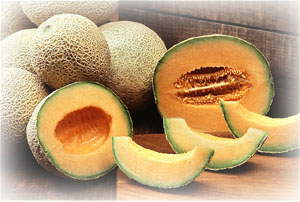
Muskmelons Originated in Persia
The muskmelon (Cucumis melo), like watermelon, is hardly a vegetable, but it is an important truck and garden crop. There is a tendency in America to refer to muskmelons merely as "melons," but that is confusing because watermelons are also loosely called "melons."
The most popular type of muskmelon in America is the small, oval, heavily netted kind commonly called a cantaloupe. All cantaloupes are muskmelons, but not all muskmelons are cantaloupes.
Muskmelons have a wide range of other forms, sizes, and flesh qualities, such as the Honey Dew, Casaba, and Persian types; the large Bender, Montreal, and such odd varieties as the elongated Banana should not be called "cantaloupes."
Muskmelon will not cross with watermelon, cucumber, pumpkin, or squash, but varieties within the species intercross freely.

Muskmelon is so named because of the delighful odor of the ripe fruits. Musk is a Persian word for a kind of perfume; melon is French, from the Latin melopepo, meaning "apple-shaped melon" and derived from Greek words of similar meaning.
Muskmelon is native to Persia (Iran) and adjacent areas on the west and the east. Persia and the trans-Caucasus are believed to be the main center of origin and development, with a secondary center including the northwest provinces of India, also Kashmir and Afghanistan. Although truly wild forms of C. melo have not been found, several related wild species have been noted in those regions.
The oldest supposed record of muskmelon goes back to an Egyptian picture of the period around 2400 B.C. In an illustration of funerary offerings of that time appears a fruit that some experts have identified as muskmelon, although others are not so sure.
Columbus Brought Muskmelon Seeds
The Greeks appear to have known the fruit in the 3d century B.C., and in the 1st century after Christ it was definitely described by the Roman philosopher Pliny, who said it was something new in Campania. The Greek physician, Galen, in the 2d century, wrote of its medicinal qualities, and Roman writers of the 3d century gave directions for growing it and preparing it with spices for eating. The Chinese apparently did not know the muskmelon until it was introduced to their country around the beginning of the Christian Era from the regions west of the Himalayas.
Culture of the muskmelon spread westward over the Mediterranean area in the Middle Ages and was apparently common in Spain by the 15th century. Columbus carried seeds of it on his second voyage and had them planted on Isabela Island in 1494. This was doubtless its first culture in the New World. About this same time Charles VIII of France reputedly introduced muskmelons into central and northern Europe from Rome.
A Spanish writer of 1513 recognized the extremes of quality commonly found in the fruits of this plant and said: "If it is bad, it is a bad thing, we are wont to say that the good are like good women, and the bad like bad women."
The frequent occurrence of poor flavor within the species doubtless explains why its culture spread no more rapidly than it did.
Before the end of the 16th century, the muskmelon doubtless had been introduced by the Spaniards to many places in North America. In the first English colonies in Virginia and Massachusetts it was grown. The North American Indians were commonly growing it in the 17th century, as their cousins of tropical America had learned from the Spaniards to do a century earlier. In the mid-1600's the Indians of Florida, the Middle West, and New England grew it.
Many Grown in Imperial Valley
The muskmelon is reported to have been introduced into Bermuda in 1609 and by the Spaniards into California in 1683. It was grown in Brazil before 1650.
The principal types and various sizes, shapes, and colors now grown were known in the 16th century. That does not mean, of course, that our present varieties date back that far, but that the main characteristics found in our varieties were also known in those days. Improvements have been made in uniformity within varieties, in size and shape of fruits, and especially in thickness and quality of flesh.
Practically all of the cantaloupes now grown in California's Imperial Valley, the greatest melon-producing district in the country, are of special strains recently produced by plant breeders to resist the disease called powdery mildew.